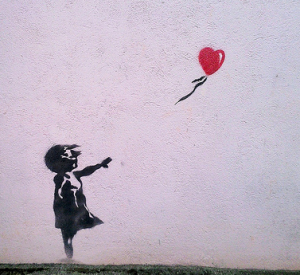By Hilary Illick
 Buddha had it right: the only constant in life is change. Life, every aspect of it – the season, the hour, the date, the state of the world, what we’re feeling, what we’re thinking, our body, our age – is in a constant state of change. Learning to let go, then, has to be one of the most important life skills we can practice.
Buddha had it right: the only constant in life is change. Life, every aspect of it – the season, the hour, the date, the state of the world, what we’re feeling, what we’re thinking, our body, our age – is in a constant state of change. Learning to let go, then, has to be one of the most important life skills we can practice.
What Is Letting Go?
But what is letting go? It is releasing our grip on something – letting go of the struggle, the resistance, the attempt to control. Letting go requires faith; trust that something other than our own attempt to stay safe will hold us. It requires remembering that there is a benevolent universal energy available to us, and trusting that when we let go of our own grip we will be held. We will rejoin that bigger universal flow.
We have all experienced this energy. At the Hoffman Process, we released ourselves from the grip of our patterns, and confronted our Dark Side energy system so we could separate from its hold. We all found ourselves, whether for short moments or sustained intervals, in the flow state. We can do that again, intentionally: Confront > Release > Flow > Repeat.
It’s Natural To Resist
It’s natural to keep going back into resistance, to contract, grip, attempt to control. In fact, life is about accepting this state of resistance and intentionally practicing letting go. We are wired to resist discomfort. We’re wired to recoil from what appears dangerous. Our brain has what is called a Negative Bias, meaning there is an evolutionary function to getting scared and recoiling. In short, it is safer to mistake a stick for a snake than a snake for a stick. So we are wired to pull back and resist at the slightest hint of danger. In our modern, comfortable world discomfort – emotional or physical – can register to our nervous system as “danger” or “threat.”
The How Of It All
Which brings us to the how. When our Spirit Guide, Hoffman teacher, yoga instructor, therapist, spouse, colleague, or friend reminds that what we need to do is let go, how do we do it? The first step in letting go is not judging the fact that you need to. Self-judgment, making ourselves wrong, is a form of resistance. It causes us to contract, clamp down, stay stuck exactly where we are.
There is an apt expression for this: “What we resist, persists.” So, not resisting ourselves – not resisting our selves – allows us to begin to let go. Try saying to yourself: OF COURSE I am gripping like this. Of course I am scared (or tense). I am wired this way. And notice what happens. You may already feel yourself breathing a bit more deeply, feeling a ripple of relief, a ray of hope.
Accept Who You Are
Accepting your state, allowing yourself to be exactly where you are and how you are, is the most compassionate thing you can do for yourself. Self-compassion and self-forgiveness are the first steps in letting go.
What happens if you skip this step? What if you stay in self-judgment, making yourself wrong, resisting yourself, your state, your life? You clamp down harder, contract more intensely, burrow more deeply into a state of resistance. And what you resist persists. Allow yourself to notice this phenomenon when it happens. And then, try bringing in self-forgiveness and self-compassion and see what happens.
Honor Your Body
The next step takes place in the body: releasing tension, letting go of the gripping, the contraction. Scan your body and notice: Where am I tensing? What muscle groups are clenched? Check in on your jaw, your shoulders, your belly, your hands, even your toes. Without judgment, observe where you are gripping, contracting, holding tension. Then, with self-love and self-compassion, allow yourself to release whatever clenching is going on in your body.
In some instances, simply releasing the gripped places in the body is all it takes to rejoin the natural-flow state of the universe. At other times, we may need to enter one more phase of letting go.
Once we have released our physical clenching, we can then bring ourselves to specific life situations or relationships where we know we are stuck. Imagine letting go, imagine letting those situations be what they are, without resisting or trying to control them. What would that be like? With letting go comes acceptance, and with acceptance, grief may arise. Or pain, or discomfort. Many aspects of life are uncomfortable, painful, and sad. Often, letting go means feeling the feelings that accompany the tough times. (Which, of course, is what we were resisting in the first place!) Here is another expression: “Feeling is healing.” Letting go lets us move through our pain, through our discomfort, and out the other side.
Listen to the guided visualization led by Hilary:
And listen to other visualizations on our audio page by clicking here.